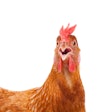
Sustainability must be at the forefront of the egg industry’s guiding principles, especially with the emergence of a new generation of consumers for whom the issue is a major concern.
A recent survey in 28 countries showed that 57% of consumers are willing to change their purchasing habits to help reduce negative environmental impacts. In fact, for food purchases, 44% of consumers are considered to be purpose-driven, meaning they are willing to alter their food purchasing habits for the good of the planet. Only 35% of consumers in the survey were classed as value-driven.
Strong position
The egg sector has already demonstrated its ability to provide great nutrition with a low impact on the planet.
The Food and Agriculture Organization global assessment of all animal production emissions clearly showed that eggs have the lowest total greenhouse gas emissions (GHGs) of all animal products – only 2.8% of total emissions - and the lowest emissions per kilogram of protein produced, about 30 kg CO2 equivalent per kg of protein.
Egg producers, like many of their counterparts in other agricultural sectors, have managed, over the past 50 years, to significantly increase production while reducing its environmental impact.
In the U.S., egg production between 1960 and 2010 increased by 30% while eutrophying emissions – those that release nitrogen and phosphorus into waterways and affect aquatic systems - and GHG emissions were reduced by 54% and 63%, respectively. These improvements were through innovations and the adoption of new practices in terms of nutrition, genetics, animal health and management.
Right direction?
However, under pressure from consumers, the egg sector is altering its practices, switching to production systems, such as cage-free housing, or abandoning management methods that have served it well, for example, beak treatments.
These new practices are making our sustainability journey much harder and moving us backward in terms of egg production’s environmental impact.
The emissions generated by cage-free systems have been reported to be up to 18% higher than those from cage systems, mainly due to higher feed consumption, higher mortality and lower productivity. The FAO global GHG emissions assessment showed that the egg industry’s main sources of emissions were feed production (69% of the total), manure management (20%) and post-farm transport and processing (11%).
Guided directions
There are some areas where producers have greater control over emissions than others. Manure management is one of those areas fully within producers’ control, but few probably realize the difference in environmental impact between dry and wet litter management approaches. Wet manure management contributes about 5 times more to total emissions than dry manure management. Realizing this, farmers may move away from wet manure management.
While farmers may exert less control over feed ingredient production, their formulation decisions not only impact products but also have a wide range of effects on emissions.
The Life Cycle Analysis model, which measures a product’s cradle to grave impact, tends to be conducted at the national level only and rather infrequently, meaning that while this approach may offer some guidance in reducing the egg sector’s environmental impact, it cannot help specific farms or individual situations.
To continue becoming more sustainable and further reduce the environmental impacts of egg production, we need smart tools that will allow us to see the impacts of decisions in real-time. As often said, you can only improve what you can measure and track.
Japan consuming more eggs, despite population stagnation:
www.WATTPoultry.com/articles/41113















